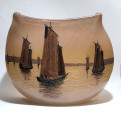François Théodore Legras ( - )
François Théodore Legras was born on December 27, 1839 in a small hamlet in the Vosges region of Lorraine, like many other master glassmakers. At the age of 20, he began working as a clerk in glassworks near his native hamlet. It was here that he learned his trade.
In 1863, he left his village to become a clerk at a glassworks in Saint-Denis, 93, where six months later he became production manager. In 1866, at the age of 27, he became manager of the glassworks. He built a new, modern factory and a workers' housing estate, which over the years grew into an industrial complex covering almost 20,000 square meters. He became Chairman and CEO of Legras et Cie, then of Verrerie et Cristallerie de Saint-Denis. Within a few years, the Legras factory had grown to 1,400 workers and nearly 150 decorators, making it the largest Art Nouveau glassworks in the Paris basin.
He took part in numerous national and international exhibitions, often winning awards. In 1900, when the Universal Exhibition was being held in Paris, Legras was appointed head of the glass and crystal section, a crowning achievement for a man of his profession.
In 1909, he handed over management of the company to his nephew Charles Legras. From 1914 onwards, the company's production changed style, taking inspiration from Art-Deco, with a return to simple lines and a certain sobriety. Legras production continued until 1928.
Objects by Legras are largely inspired by nature: fauna, flora and natural landscapes. The trees of his native land were an enormous inspiration. Through his creations, Legras succeeded in making "beauty out of utility", as he himself confided. Some might see this as the first steps towards industrialization in art, but it's clearly the result of a fierce desire to make art accessible to as many people as possible.


